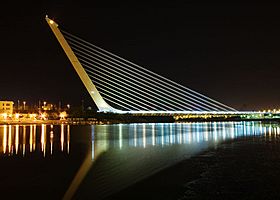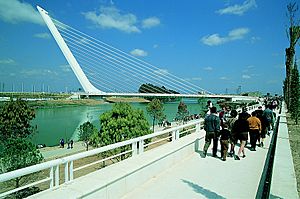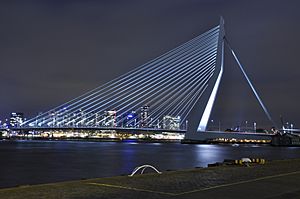Alamillo Bridge facts for kids
Quick facts for kids Alamillo Bridge |
|
|---|---|

The Alamillo Bridge at night
|
|
| Coordinates | 37°24′48″N 5°59′25″W / 37.41333°N 5.99028°W |
| Carries | three lanes of motor vehicles on each side, separate and elevated center lane for pedestrians and bicycles |
| Crosses | Guadalquivir river |
| Locale | Seville (Andalusia–Spain) |
| Preceded by | Pasarela de San Jerónimo |
| Followed by | Puente de la Barqueta |
| Characteristics | |
| Design | Cantilever spar cable-stayed bridge with no backstays or anchorage |
| Total length | 250 m |
| Height | 140 m with tower inclined backward 32 degrees from vertical |
| Longest span | 200 m |
| History | |
| Designer | Santiago Calatrava |
The Alamillo Bridge (Spanish: Puente del Alamillo) is a famous bridge in Seville, Andalusia (Spain). It crosses the Canal de Alfonso XIII, which helps people get to La Cartuja. This area is a peninsula located between the canal and the Guadalquivir River. The bridge was built for Expo 92, a big world's fair held in Seville. Construction started in 1989 and finished in 1992. It was designed by the well-known architect Santiago Calatrava.
How the Bridge Was Designed

The idea for the Alamillo Bridge came from a sculpture by Calatrava called 'Running Torso' in 1986. This sculpture showed how stacked marble cubes could be balanced by a tight wire.
The Alamillo Bridge has a single, straight steel tower. This tower is filled with concrete and leans backward. It balances a 200-meter (656-foot) long bridge deck using thirteen pairs of strong cables. Because the tower is heavy enough to balance the bridge deck, it doesn't need extra support cables at the back. This was a new way to build a cantilever spar cable-stayed bridge when it was designed in 1987.
Originally, there were plans to build two identical bridges. However, the unique, one-sided design of the Alamillo Bridge ended up being much more impressive.
The bridge deck has a strong hexagonal (six-sided) steel beam in the middle. The support cables are attached to this beam. Steel "wings" stick out from the sides of this beam, holding up the traffic lanes. There are three lanes for cars on each side. The top of the hexagonal beam is about 1.6 meters (5 feet) higher than the road. This elevated part is a special path for people to walk and cycle, right between the traffic lanes.
This bridge showed the big dreams of Seville as it got ready for Expo '92. You can even see it from the top of La Giralda, a famous old tower in the city. It connects Seville's history with its modern future. Like the Brooklyn Bridge, it has a raised walkway for people. The Alamillo Bridge also has a lookout point at the top of its leaning tower. You can reach it by stairs inside the tower.
The Alamillo Bridge was the first cable-stayed bridge that balances only with the weight of its huge tower. It doesn't need any extra cables or anchors at the back. There are 54 steel poles under the bridge that help support the tower. Other bridges designed by Calatrava, like the Sundial Bridge in Redding, California (2004) and the Chords Bridge in Jerusalem (2008), have a similar design.
What People Think About the Bridge
Many people think the Alamillo Bridge looks amazing and is very dramatic. However, some engineers have pointed out that its design, without back support cables, makes it less efficient when loads change. For example, the main tower of the Alamillo Bridge is much heavier than the tower of the Erasmus Bridge in Rotterdam. The Erasmus Bridge also has a leaning tower but uses back support cables. The tower of the Alamillo Bridge is over 10 times heavier than the tower of the Erasmus Bridge, even though the Erasmus Bridge is longer.
See Also
 In Spanish: Puente del Alamillo (Sevilla) para niños
In Spanish: Puente del Alamillo (Sevilla) para niños
- Puente de la Mujer, Buenos Aires, Argentina
- Samuel Beckett Bridge, Dublin, Ireland
- Sundial Bridge at Turtle Bay, California, United States
- Puente de la Unidad, Monterrey, Mexico
- Erasmus Bridge, Rotterdam, Netherlands




